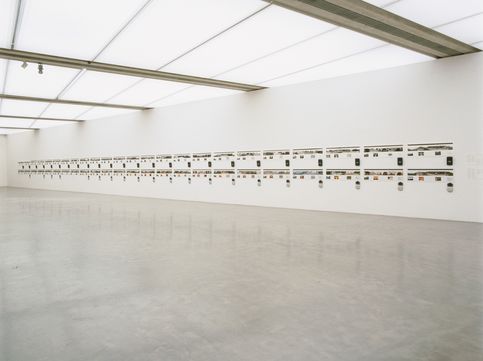Dokumentarische Dialektstudie II vom Fersental bis Garmisch-Partenkirchen

Norbert Brunner/Michael Schuster
Dokumentarische Dialektstudie II vom Fersental bis Garmisch-Partenkirchen, 1999
Audio-photo installation 24 parts 24 color photographs (digital printouts 2001), dry-mounted on 24 foamcore boards (40 x 124 cm each), 24 CD players with 24 CD-Roms (74 min each), 24 loud-speakers Total dimensions variable Edition 1/3 Documented places: St. Franz, Neumarkt, Terlan, Müstair, Taufers, Laas, Algund, Sarnthein, Gummer, Bozen, Villnöss, Miland, Abfaltersbach, Vintel, Kematen, Telfes, Mühlbachl, Götzens, Seefeld, Scharnitz, Leutasch, Ehrwald, Grainau, Oberau. The order of the single parts (1-24) corresponds to the geographic line of the analyzed villages from South to North.
GF0002219.00.0-2001
Artwork text
Michael Schuster and Norbert Brunner have once again conducted their Documentary Dialectal Study, elaborated in 1979, for the steirischer herbst 99. On the basis of a detailed, pre-specified score, the project photographically documents the course of a landscape (from Trentino through southern Tyrol to Bavaria) and the change in the Tyrolean dialect in tape recordings and phonetic transcriptions. The subject of this linguistic study is the Lord’s Prayer, a closed, simply coded text unit, similar to a ready-made, which lends itself to an analysis of regional linguistic differences. Automation of the photographs— accomplished by predefining the camera location and recording interval—is made comprehensible for the viewer within the structure of the work. The strictly documentary use of the medium of photography—non-photography as Schuster terms it—fully conforms to the title ”study” chosen by the artists for their work. The conditions governing the process of image creation—the passing of time, the day-night succession—are a constitutive factor and at the same time the aesthetic base of the work. Repetition is an intrinsic element of the project: the Lord’s Prayer, but also the photographs shot at regular intervals, introduces a repetitive structure into the linear recording of space. Repetition of the project twenty years later adds historical comparison, a substantially new component to the sociological and conceptual quality of this work. (Christine Frisinghelli)
























